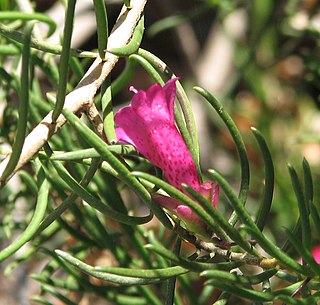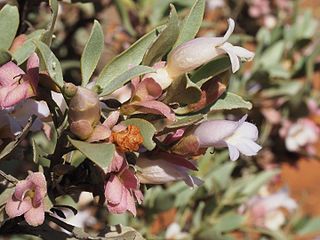
Eremophila alternifolia, commonly known as narrow-leaved poverty bush, is a plant in the figwort family, Scrophulariaceae, and is endemic to areas between the far west of New South Wales, the far south of the Northern Territory and the southern half of Western Australia. It is a variable shrub, with respect to its growth form, leaf shape and flower colour. Aboriginal Australians used the leaves to treat ailments such as colds and skin infections and pharmacological testing has shown that the leaves contain compounds that affect cardiac activity.

Eremophila bowmanii, also known as silver turkeybush, Bowman's poverty bush and flannel bush, is a flowering plant in the figwort family, Scrophulariaceae and is endemic to New South Wales and Queensland in Australia. It is a low to medium, spreading shrub with silvery-grey, hairy foliage and blue to lilac flowers, and sometimes grows in dense thickets with mulga.

Flindersia australis, commonly known as crow's ash, flindosy or Australian teak, is a species of tree that is endemic to north-eastern Australia. It has pinnate leaves with between five and thirteen egg-shaped to elliptical leaflets, white to cream-coloured flowers arranged in panicles on the ends of branchlets and followed by woody capsules studded with short, rough points and containing winged seeds.

Angophora subvelutina, commonly known as the broad-leaved apple, is a species of tree that is endemic to eastern Australia. It has rough bark on the trunk and branches, lance-shaped to egg-shaped or elliptical adult leaves, flower buds in groups of three or seven, white or creamy white flowers and ribbed, cup-shaped fruit.

Diuris chryseopsis, commonly known as common golden moths or the small snake orchid, is a species of orchid that is endemic to south-eastern Australia. It is a common and widespread species growing in woodland, often in colonies and has up to four drooping, golden-yellow flowers. It is similar to several other orchids and form hybrids with some other Diuris species.

Persoonia daphnoides is a plant in the family Proteaceae and is endemic to a restricted area near the border of eastern New South Wales and Queensland. It is a prostrate shrub with spatula-shaped to egg-shaped leaves with the narrower end towards the base, and yellow flowers in groups of up to eight on a rachis up to 35 mm (1.4 in) long.
Eremophila papillata is a flowering plant in the figwort family, Scrophulariaceae and is endemic to Western Australia. It is an erect, compact shrub with sticky, narrow leaves and mauve, blue or purple, rarely white flowers.

Eremophila tietkensii is a flowering plant in the figwort family, Scrophulariaceae and is endemic to Australia. It is a rounded to flat-topped shrub with grey-green leaves, usually pinkish-purple sepals and mauve, pink or lilac-coloured petals. It is mostly found in Western Australia but also occurs in the far west of the Northern Territory.

Gunniopsis is a genus of flowering plants in the iceplant family, Aizoaceae. These plants are found in areas of inland Australia.
Gunniopsis quadrifida, the Sturts pigface, is a plant endemic to Australia that is within the family Aizoaceae. This family consists of a diverse array of species that inhabit arid and/or saline coastal and inland areas, with the plants displaying leaf morphology that is conducive to such harsh environments. Typical features of members of this genus that lie within this family of succulents includes the presence of fleshy-leaves that acts as a water reservoir for the plant with the habit of a smalls shrub.
Gunniopsis calcarea, commonly known as the Nullarbor Gunniopsis or the yellow flowered pigface, is a succulent plant in the iceplant family, Aizoaceae. It is endemic to Australia.
Gunniopsis zygophylloides, commonly known as the twin-leaf pigface, is a succulent plant in the iceplant family, Aizoaceae. It is endemic to Australia.
Gunniopsis divisa is a succulent plant in the iceplant family, Aizoaceae. It is endemic to Western Australia.
Gunniopsis calva, commonly known as the smooth pigface, is a succulent plant in the iceplant family, Aizoaceae. It is endemic to Australia.
Gunniopsis rubra is a succulent plant in the iceplant family, Aizoaceae. It is endemic to Western Australia.
Gunniopsis septifraga, commonly known as green pigface, is a succulent plant in the iceplant family, Aizoaceae. It is endemic to Australia.
Gunniopsis tenuifolia, commonly known as the narrow-leaf pigface, is a succulent plant in the iceplant family, Aizoaceae. It is endemic to Australia.
Gunniopsis kochii, commonly known as the Koch's pigface, is a succulent plant in the iceplant family, Aizoaceae. It is endemic to Australia.

Phebalium obcordatum, commonly known as the club-leaved phebalium, is a species of shrub that is endemic to New South Wales. It has smooth branchlets, small egg-shaped to heart-shaped leaves with the narrower end towards the base and small umbels of pale yellow flowers with silvery scales on the back of the petals.

Prostanthera wilkieana is a species of flowering plant that is endemic to the more arid areas of Australia. It is an erect, densely-branched shrub with elliptic to narrow egg-shaped leaves with the narrower end towards the base and mauve to pale violet or white flowers with deep purple streaks and yellowish brown dots inside the petal tube.










